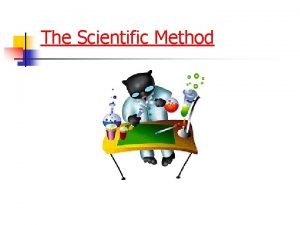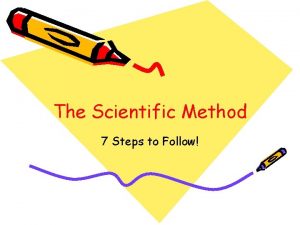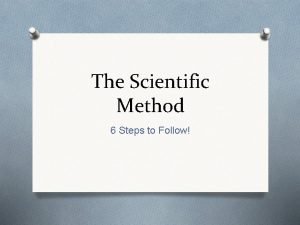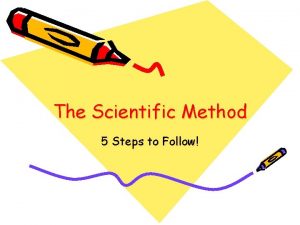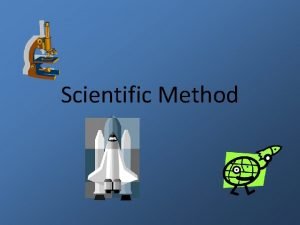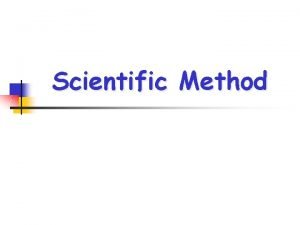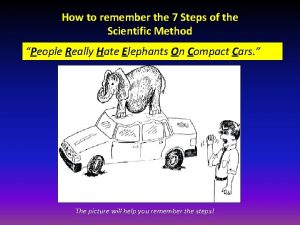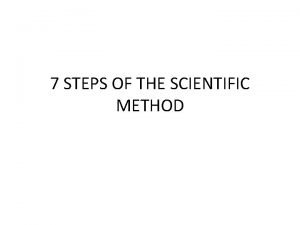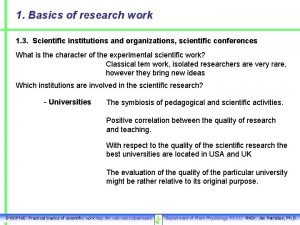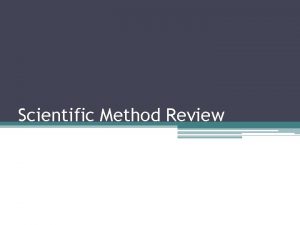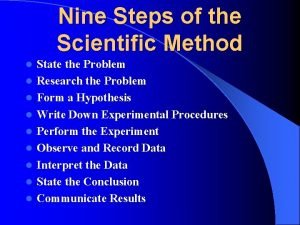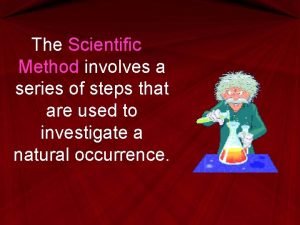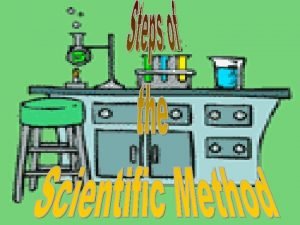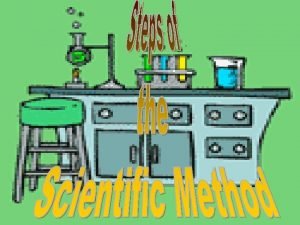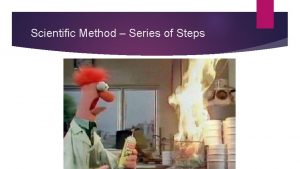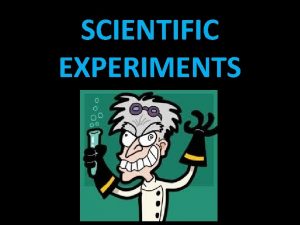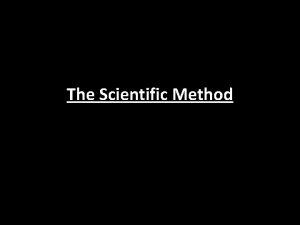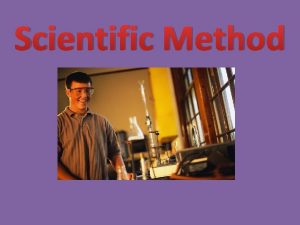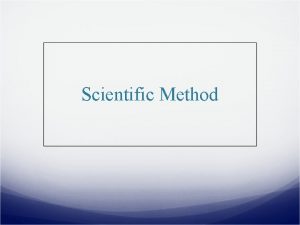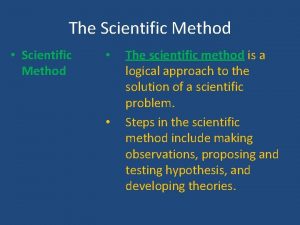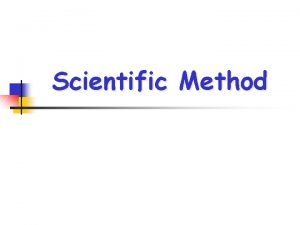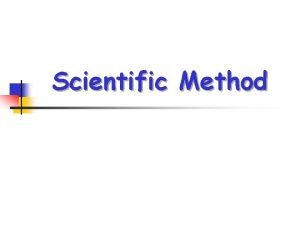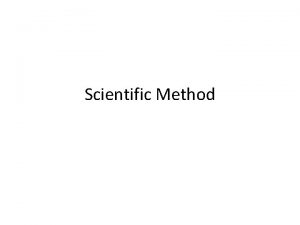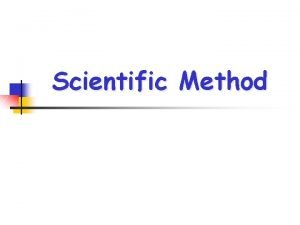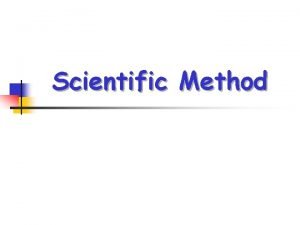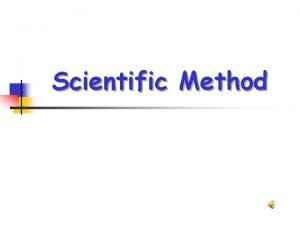Scientific Method Scientific Method Series of steps to






















- Slides: 22

Scientific Method

Scientific Method • Series of steps to solve a problem or a question • Solving problems requires organization • There are six steps to follow

Scientific Method 1. Ask a question or state the problem.

Scientific Method 2. Gather Information or do background research • Use the internet or library resources to research your problem

Hypothesis 3. Construct your hypothesis • Hypothesis-a prediction that can be tested • Can be a possible solution to your problem or question • Must use the words…if…then( if=the cause…then=the effect)

Hypothesis 4. Test the hypothesis • Write a procedure – Must numbered steps – No pronouns (I, we, etc. ) – Must be descriptive – Exact so that any scientist could replicate the steps • Gather materials • Carry out the experiment—need to identify the variables

Variables • Independent Variable—the variable that is being changed in the experiment • Only ONE factor at a time can change • Dependent Variable—the variable that can be measured, what you are looking to find • Control—the part of the experiment that is kept the same, unchanged

Experiments • Experiments must be done many times to be sure that the independent variable is actually causing the changes • The more experiments performed, the more accurate the results • A controlled experiment only has 1 factor that changes at a time • In an experiment, there needs to be an experimental group and a control group.

DOS 1. For the following scientific question, identify the independent and dependent variables and control: “Which type of light bulb burns the longest? ” 2. Derek lives in a hot humid cilmate. He has two rose bushes in pots in his yard. The rose bushes grow quickly and bloom large, red roses. Derek moves to a cold, dry climate at the same altitude and notices that his rose bushes stop growing and do not have large blooms. He hypothesizes that the rose bushes are not receiving enough water because he is now in a dry climate. He waters them more often, but they do not improve. Which of the following scientific questions should he ask next to find out what is wrong with his roses? A. How much do rose bushes cost in his new area? B. Do rose bushes grow better in high or low altitudes. C. Which rose bush has larger, more colorful blooms? D. Does temperature affect the growth of those rose bushes.

DOS 4. A p. H meter will measure how _______ or _______ a substance is. A. acidic, alkaline B. alkaline, hot C. acidic, hot D. long, acidic 5. Ken needs to measure out 50 m. L of water. Which of the following is the best tool for Ken to use? A. graduated cylinder B. Test tube C. balance D. beaker

DOS 6. What is the volume of the liquid in the graduated cylinder shown below? A. B. C. D. 27 m. L 27. 5 m. L 26 m. L 28. 0 m. L

Experiments • Control Group—is the normal way, the group that has nothing changing – It is used to compare to the experimental group • Experimental Group--is just like the control group BUT has 1 factor that is changing (independent variable)

Analyze Results 5. Analyze your Results--organize the results/data in a clear way to learn what occurred, use charts, tables, graphs to help organize the data • 2 kinds of data – Qualitative (descriptions) – Quantitative (numbers)

Observations • Qualitative data – Describes – Tells the ‘quality’ of the data – Data that does not have numbers – Gives physical description…color, shape, size, smell, etc. • Quantitative data • Numbers • Give the ‘quantity’—tells how much or how many

Graphing Step What to Do How to Do It 1 Identify the variables. a. Independent Variable (controlled by the experimenter—what is being changed) --Goes on the X axis(horizontal) --Should be on the left side of a data table b. Dependent Variable(What is being measured) --Goes on the Y axis(vertical) Should be on the right side of a data table

Graphing Step What do do How to do it 2. Determine the Variable Range. a. Subtract the lowest data value from the highest data value. b. Do each variable seperately. 3 Determine the Scale of the graph. a. Determine a scale (the numerical value for each square), that best fits the range of each variable. b. Spread the graph to use MOST of the available space.

Step What to do 4 Number and label each axis. a. This tells what data the lines on your graph represent. Label both the x and y axis. 5 Plot the data points a. Plot each data value on the graph with a dot. b. You can put the data number by the dot, if it does not clutter your graph. 6 Draw the graph. a. Draw a best fit line. b. Most graphs of experimental data are not drawn as “connectthe-dots. 7 Title the graph a. If your graph has more Your title should clearly tell than one set of data, what the graph is about. provide a “key” to Incorporate both variables identify the different into the title. lines. Graphing How to do it

Checkpoint! 1. Name the six steps of the scientific method. 2. What is a hypothesis? 3. Construct a hypothesis for the question, “Will a water filled with balloon burst if exposed to a flame? ” 4. What are the two types of observations?

Checkpoint! 5. Day Plant 1 (Control) Plant 2 (10 Plant 3 (50 Plant 4 (100 m. L of water) 1 0 cm . 1 cm . 6 cm 2 . 05 cm . 2 cm . 3 cm . 1 cm 3 . 05 cm . 2 cm . 5 cm . 1 cm 4 0 cm . 3 cm 1 cm 0 cm 5 . 05 cm . 2 cm 6 0 cm . 05 cm . 1 cm . 05 cm 7 0 cm 0 cm . 2 cm . 05 cm

Quantitative Data • System of measurement in science is called the International System of Units, or SI • Length – 1 meter=100 cm=1000 mm – 1 km=1000 m • Volume – 1 L=1000 m. L • Mass – 1 kilogram(kg)=1000 grams(g) – 1 gram=1000 milligram

Conversions • King Henry Danced Christmas Morning M errily During

Conclusions 6. Draw Conclusions--do the results support the hypothesis? • It is OK if the hypothesis is wrong, if wrong it usually leads to new questions being asked and in turn leads to new experiments • Communicate your results, orally or written, to the science community
 7 steps of the scientific method
7 steps of the scientific method 7 steps of the scientific method
7 steps of the scientific method Scientific method seven steps
Scientific method seven steps What are the 6 steps in the scientific method
What are the 6 steps in the scientific method What are the 5 steps in the scientific method
What are the 5 steps in the scientific method Examples of problems using scientific method
Examples of problems using scientific method Scientific method steps
Scientific method steps Steps of scientific method
Steps of scientific method What are the 7 steps of the scientific method
What are the 7 steps of the scientific method What are the 7 steps of the scientific method
What are the 7 steps of the scientific method Steps of scientific method
Steps of scientific method What are the six steps of the scientific method
What are the six steps of the scientific method What are the nine steps of the scientific method
What are the nine steps of the scientific method Scientific method steps
Scientific method steps Scientific method steps
Scientific method steps Scientific method steps
Scientific method steps Scientific method steps
Scientific method steps Information gathered during an experiment
Information gathered during an experiment Maclaurin series vs taylor series
Maclaurin series vs taylor series Balmer series lyman series
Balmer series lyman series Taylor series of composite function
Taylor series of composite function Taylor frederick
Taylor frederick Ibm p series vs i series
Ibm p series vs i series
